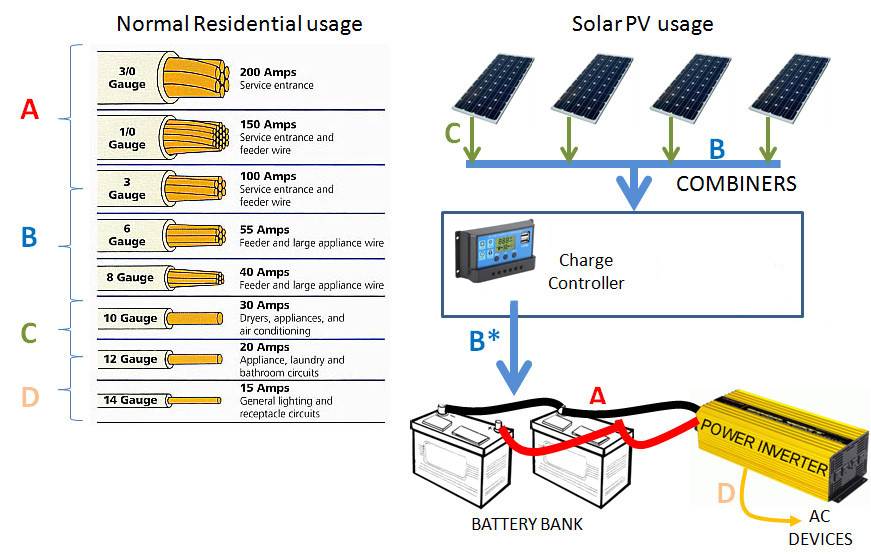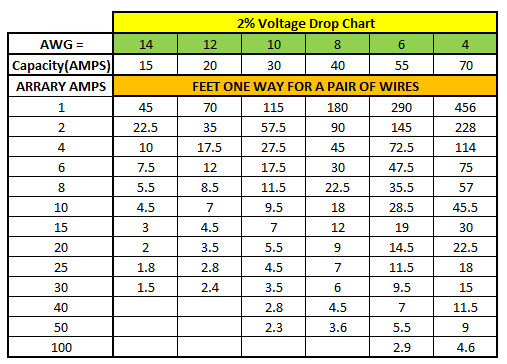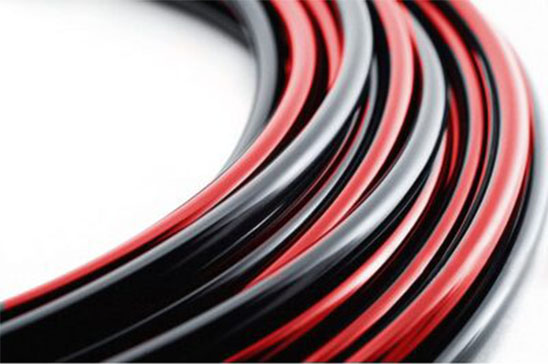Uncategorized
Choosing the Right Wire Size
Choosing the right wire sizes in your PV system is important for both performance and safety reasons. If the wires are undersized, there will be a significant voltage drop in the wires resulting in excess power loss. In addition, if the wires are undersized, there is a risk that the wires may heat up to the point in which a fire may result.
An electrical wire carries current much like a water hose carries water. The larger the diameter of the water hose, the less resistance there is to water flow. Moreover, even with a large diameter hose, shorter hoses have better flow than longer hoses. Longer hoses have more resistance than shorter ones of the same diameter. Electrical wires behave the same manner. If your electrical wires (the copper gauge) are not large enough or if the cable is longer than needed, then the resistance is higher resulting in less watts going to either your battery bank or the grid.
Copper wires are sized using the gauge scale: American Wire Gauge (AWG). The lower the gauge number, the less resistance the wire has and therefore the higher current it can handle safely.
The chart below shows the capacity of various wire gauge sizes and their typical amp rating and application for both residential and solar applications.

Commercial solar PV panels over 50 watts or so use 10 gauge (AWG) wires. This allows up to 30 amps of current to flow from a single panel. If multiple panels are combined in parallel, then a three to eight AWG “combiner” wire set is generally needed to safely transfer the power to a charge controller.
The wires from the charge controller to the battery bank can generally be the same or larger gauge than the main set from the PV array. The exception (B*) is when the Charge Controller is of the type that can operate a 12 or 24-volt battery bank even when the PV array is operating at higher voltages, such as 48 Vdc and larger. These Charge Controllers have large transformers that lower the voltage but in the process they increase the current going to the battery bank. Refer to the installation material for the charge controller you chose when selecting the correct wire size to use.
The wires between batteries in a battery bank tend to be the largest in the system since they are used in conjunction with a power inverter that can at times demand more current than that the PV system can supply on its own. These same wires will also have to carry current used simultaneously for charging and for power inversion. A typical battery bank wire size is 1/0.
It is very important to match the gauge and the wire lengths when combining batteries in a battery bank. If this is not done, then the battery bank’s life can be shortened and certain safety issues can result.
Wire run lengths
Usually the longest wire run is from the PV array to the location where the charge controller is located. Since all of the combined PV power flows through this wire set, we really need to choose it correctly to maximize performance and to assure safety.
The general rule-of-thumb is to stay below 2% Voltage drop on this run. Using the known resistance of the various wire gauges, it is possible to calculate the maximum length for a wire-pair for each wire gauge size.
Here is what that calculation looks like for a 12V PV system. You can double the length for a 24V system, or quadruple it for a 48V system.

Example: Let’s take a 450-watt 12V system. At the Vmp of 18V, the maximum current is 450/18 = 25 amps.
Looking at the wire capacity row, 10 AWG is the smallest gauge wire that can safety be used. It is rated at 30 amps, higher than the required 25 amps.
Next, we look at the Array amps column, select row “25” and you can see that a 10 AWG wire pair only supports a cable length of 4.5 feet! Going up to 4 AWG supports up to 18 feet to stay within the 2% loss criteria. This is not a lot of feet!
What this example illustrates is that we need to greatly appreciate the issue of cable length and its effect on losses. Many people have long cable runs and don’t realize the impact this has on performance. Sometimes we have to tolerate perhaps a 4% loss rather than 2%, allowing us to double the length values shown in the table. Another option is to operate at a higher voltage, such as 24V. This reduces the amps which reduces the wire losses.
The point is to design your system using a safe wire size but also to be conscious of the trade-off between system voltage, wire length, line losses, and costs. This is why planning should be done in detail before you rush out to buy things like cables.

